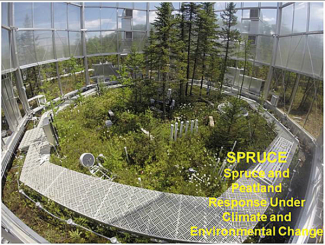SPRUCE Total Gaseous Mercury Fluxes and Peat Mercury Concentrations, 2014-2015
Description
This data set reports the results of total gaseous mercury (TGM) flux monitoring conducted in a sub-set of the SPRUCE experimental study enclosures (Plots 4, 6, 10, 13, 17 and 19) located in the S1 Bog. These plots were selected to represent duplicates of the +0, +4.5 and +9°C experimental temperature treatments. Monitoring of TGM fluxes was conducted in May-June 2014, August 2014 and June 2015 to capture the influence of the deep (2 m below the ground surface) peat warming experiment. These sampling events were conducted prior to the initiation of deep peat warming (May-June 2014), once target peat temperatures were achieved at depth (August 2014) and at the conclusion of the deep warming experiment prior to the initiation of whole ecosystem warming (June 2015).
This data set also presents the total mercury (Hg) concentration for peat samples collected during the group sampling campaigns, involving a team of SPRUCE investigators and collaborators, in June 2014 (prior to deep peat warming experiment), September 2014 (target temperatures achieved at depth) and June 2015 (end of deep warming experiment and prior to whole ecosystem warming). Peat samples for total mercury analysis were collected from Enclosures 4, 6, 8, 10, 11, 13, 16, 17, 19, 20.
Citation
Haynes, K.M., C.P.J. Mitchell, R.K. Kolka. 2019. SPRUCE Total Gaseous Mercury Fluxes and Peat Mercury Concentrations, 2014-2015. Oak Ridge National Laboratory, TES SFA, U.S. Department of Energy, Oak Ridge, Tennessee, U.S.A. https://doi.org/10.25581/spruce.066/1512288
Download
Posted
Monday, May 13, 2019
SPRUCE ID: spruce.066
Public






